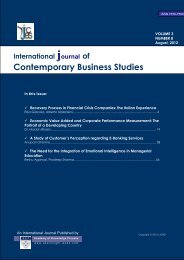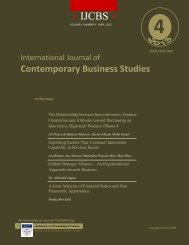International journal of Contemporary Business Studies
International journal of Contemporary Business Studies
International journal of Contemporary Business Studies
Create successful ePaper yourself
Turn your PDF publications into a flip-book with our unique Google optimized e-Paper software.
<strong>International</strong> Journal <strong>of</strong> <strong>Contemporary</strong> <strong>Business</strong> <strong>Studies</strong><br />
Vol: 3, No: 6. June, 2012 ISSN 2156-7506<br />
Available online at http://www.akpinsight.webs.com<br />
competitiveness.The question, posed now is: which dimension <strong>of</strong> budgetary participation has a<br />
significant effect in the studied relationship?<br />
The answer to this question will depend on the results <strong>of</strong> subsequent regressions.<br />
4.2.3. Dimensional analysis: effect <strong>of</strong> the “involvement”<br />
Panel C <strong>of</strong> Table 7 shows an adjusted R2coefficient equal to 15.1%.<br />
The regression coefficient α is 0.451, it is positive and significant (t = 3.29 at 5% level). This<br />
result confirms the hypothesis 2 that there exists a positive relationship between the size <strong>of</strong><br />
"involvement" <strong>of</strong> budgetary participation and organizational performance <strong>of</strong> the company when<br />
there is a high level <strong>of</strong> competitiveness. In a similar context, Jermias & Setiawan (2008) and<br />
Chong et al., (2005) find same results.<br />
4.2.4. Dimensional analysis: effect <strong>of</strong> the “influence” dimension <strong>of</strong> budgetary participation<br />
Hypothesis 3 posits that the dimension "influence" <strong>of</strong> the budgetary participation, in interacting<br />
with the intensity <strong>of</strong> competitiveness, hasn‟t a significant effect on organizational performance.<br />
The model referred to this case (Panel D <strong>of</strong> table 7) doesn't present a sizeable explanatory power<br />
(adjusted R ² = 10.2%).<br />
The regression coefficient is positive (0.076) but not significant with a value t-statistic equal to<br />
1.23. So the dimension "influence" <strong>of</strong> the budgetary participation has no significant effect on<br />
organizational performance <strong>of</strong> firms in a context <strong>of</strong> strong competitiveness. This confirms the<br />
third hypothesis. The results <strong>of</strong> linear regressions are aligned with those obtained by Hassel &<br />
Cunningham (1993, 1996).<br />
CONCLUSION<br />
This study examined the impact <strong>of</strong> budgetary participation on organizational performance<br />
through the intensity <strong>of</strong> market competition. It <strong>of</strong>fers a combination <strong>of</strong> strong budgetary<br />
participation and a high level <strong>of</strong> competitiveness will enable to improve organizational<br />
performance <strong>of</strong> firms. The conduct <strong>of</strong> this work was largely influenced by the study <strong>of</strong> Chong<br />
and al., (2005) and that <strong>of</strong> Jermias & Setiawan (2008). In general, the results obtained confirm<br />
the hypotheses developed in this study. They showed that the "involvement" dimension <strong>of</strong> the<br />
budgetary participation is a source <strong>of</strong> improved organizational performance especially under<br />
conditions <strong>of</strong> high competitiveness. A dimensional analysis <strong>of</strong> the budgetary participation into<br />
two factors "involvement" and “influence” showed that only the first dimension involve in<br />
interaction with the intensity <strong>of</strong> market competition to increase organizational performance. The<br />
contribution <strong>of</strong> this work appears in two levels. From a theoretical perspective, the results <strong>of</strong> this<br />
study may enrich the management accounting literature, and introducing <strong>of</strong> "market competition"<br />
as new contingency factor. In practical terms, the results are an encouragement tool <strong>of</strong> company<br />
managers to budgetary participation especially in situations <strong>of</strong> high competitiveness to improve<br />
the performance <strong>of</strong> their businesses. It is important to remember that this research suffer from a<br />
number <strong>of</strong> limitations. Indeed, the sample size is limited which makes it difficult to generalize<br />
the results. On the other hand, instruments for measuring variables even if they are to criticism,<br />
our choice are justified for the sake <strong>of</strong> comparison.<br />
Copyright © 2012. Academy <strong>of</strong> Knowledge Process<br />
46
















